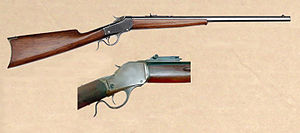
In firearm designs, the term single-shot refers to guns that can hold only a single round of ammunition inside and thus must be reloaded manually after every shot. Compared to multi-shot repeating firearms ("repeaters"), single-shot designs have no moving parts other than the trigger, hammer/firing pin or frizzen, and therefore do not need a sizable receiver behind the barrel to accommodate a moving action, making them far less complex and more robust than revolvers or magazine/belt-fed firearms, but also with much slower rates of fire.

A cartridge, also known as a round, is a type of pre-assembled firearm ammunition packaging a projectile, a propellant substance and an ignition device (primer) within a metallic, paper, or plastic case that is precisely made to fit within the barrel chamber of a breechloading gun, for convenient transportation and handling during shooting. Although in popular usage the term "bullet" is often used to refer to a complete cartridge, the correct usage only refers to the projectile.

In firearms terminology, an action is the functional mechanism of a breech-loading firearm that handles the ammunition cartridges, or the method by which that mechanism works. Actions are technically not present on muzzleloaders, as all those are single-shot firearms with a closed off breech with the powder and projectile manually loaded from the muzzle. Instead, the muzzleloader ignition mechanism is referred to as the lock.

John Moses Browning was an American firearm designer who developed many varieties of military and civilian firearms, cartridges, and gun mechanisms, many of which are still in use around the world. He made his first firearm at age 13 in his father's gun shop and was awarded the first of his 128 firearm patents on October 7, 1879, at the age of 24. He is regarded as one of the most successful firearms designers of the 19th and 20th centuries and a pioneer of modern repeating, semi-automatic, and automatic firearms.
Winchester rifle is a comprehensive term describing a series of lever action repeating rifles manufactured by the Winchester Repeating Arms Company. Developed from the 1860 Henry rifle, Winchester rifles were among the earliest repeaters. The Model 1873 was particularly successful, being marketed by the manufacturer as "The Gun That Won the West".
A semi-automatic firearm, also called a self-loading or autoloading firearm, is a repeating firearm whose action mechanism automatically loads a following round of cartridge into the chamber and prepares it for subsequent firing, but requires the shooter to manually actuate the trigger in order to discharge each shot. Typically, this involves the weapon's action utilizing the excess energy released during the preceding shot to unlock and move the bolt, extracting and ejecting the spent cartridge case from the chamber, re-cocking the firing mechanism, and loading a new cartridge into the firing chamber, all without input from the user. To fire again, however, the user must actively release the trigger, allow it to "reset", before pulling the trigger again to fire off the next round. As a result, each trigger pull only discharges a single round from a semi-automatic weapon, as opposed to a fully automatic weapon, which will shoot continuously as long as the ammunition is replete and the trigger is kept depressed.
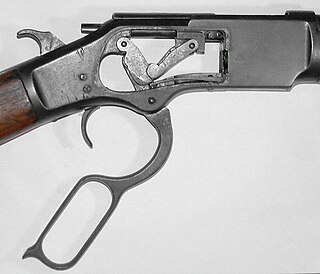
A lever action is a type of action for repeating firearms that uses a manually operated cocking handle located around the trigger guard area that pivots forward to move the bolt via internal linkages, which will feed and extract cartridges into and out of the chamber, and cock the firing pin mechanism. This contrasts to other type of repeating actions such as the bolt-action, pump-action, semi-automatic, fully automatic, and/or burst mode actions. A firearm using this operating mechanism is colloquially referred to as a levergun.

.22 Short is a variety of .22 caliber (5.6 mm) rimfire ammunition. Developed in 1857 for the first Smith & Wesson revolver, the .22 rimfire was the first American metallic cartridge. The original loading was a 29 or 30 gr bullet and 4 gr of black powder. The original .22 rimfire cartridge was renamed .22 Short with the introduction of the .22 Long in 1871.

A wildcat cartridge, often shortened to wildcat, is a custom cartridge for which ammunition and/or firearms are not mass-produced. These cartridges are often created in order to optimize a certain performance characteristic of an existing commercial cartridge, or may merely be intended as novelty items.
The Winchester Repeating Arms Company was a prominent American manufacturer of repeating firearms and ammunition. The firm was established in 1866 by Oliver Winchester and was located in New Haven, Connecticut. The firm went into receivership in 1931 and was bought by the Western Cartridge Company, a forerunner of the Olin Corporation. The Winchester brand name is still owned by the Olin Corporation, which makes ammunition under that name. The Winchester name is also used under license for firearms produced by two subsidiaries of the Herstal Group – FN Herstal of Belgium and the Browning Arms Company of Ogden, Utah.
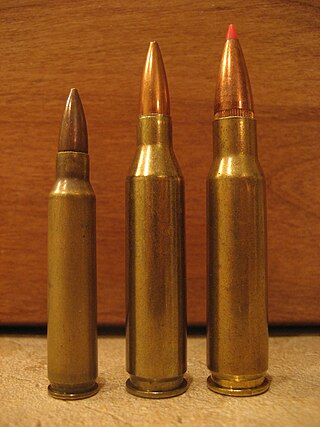
The .243 Winchester (6×52mm) is a popular sporting rifle cartridge. Developed as a versatile short action cartridge to hunt both medium game and small game alike, it "took whitetail hunting by storm" when introduced in 1955, and remains one of the most popular whitetail deer cartridges. It is also commonly used for harvesting blacktail deer, pronghorns and mule deer with heavier rounds, and is equally suited to varmint hunting with lighter rounds. The .243 is based on a necked down .308 Winchester, introduced only three years earlier. Expanding monolithic copper bullets of approximately 80 to 85 grains or traditional lead rounds of 90 to 105 grains with controlled expansion designs are best suited for hunting medium game, while lighter rounds are intended for varmints.
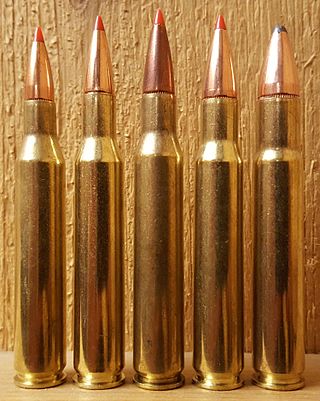
The .270 Winchester is a rifle cartridge developed by Winchester Repeating Arms Company in 1923, and it was unveiled in 1925 as a chambering for their bolt-action Model 54 to become arguably the flattest shooting cartridge of its day, only competing with the .300 Holland & Holland Magnum, also introduced in the same year.
Marlin Firearms is an American manufacturer of semi-automatic, lever-action and bolt-action rifles. In the past the company made shotguns, derringers, and revolvers. Marlin owned the firearm manufacturer H&R Firearms. In 2007, Remington Arms, part of the Remington Outdoor Company, acquired Marlin Firearms. Remington produced Marlin-brand firearms at its Kentucky and New York manufacturing facilities. In 2020, Sturm, Ruger & Co. bought the Marlin business from bankrupt Remington Outdoor Company.
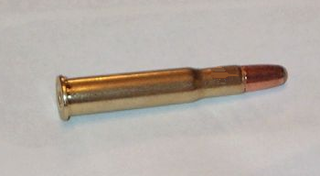
The .30-30 Winchester cartridge was first marketed for the Winchester Model 1894 lever-action rifle in 1895. The .30-30, as it is most commonly known, along with the .25-35 Winchester, was offered that year as the United States' first small-bore sporting rifle cartridges designed for smokeless powder. Since its introduction, it has been utilized alongside the development of flatter shooting cartridges, most prominently those derived from designs subsidized by interest in military expenditures, yet the .30-30 has remained in widespread use almost entirely because of reliable effectiveness in civilian applications, proven by putting food on the table for millions of people within a practical range of hunting situations.

The Remington Model 14 was a pump-action repeating rifle designed for the Remington Arms company by John Pedersen. It is part of a series of rifles that include the Remington Model 14-1/2 and the Remington Model 141.
The Marlin Model 336 is a lever-action rifle and carbine made by Marlin Firearms. Since its introduction in 1948, it has been offered in a number of different calibers and barrel lengths, but is commonly chambered in .30-30 Winchester or .35 Remington, using a 20- or 24-inch barrel. Currently, the model with a 24-inch barrel is only available in .30-30 Winchester. The Model 336 is now back in production as of March 27, 2023.
The Winchester Model 1894 rifle is a lever-action repeating rifle that became one of the most famous and popular hunting rifles of all time. It was designed by John Browning in 1894 and originally chambered to fire two metallic black powder cartridges, the .32-40 Winchester and .38-55 Winchester. It was the first rifle to chamber the smokeless powder round, the .30 WCF in 1895. In 1901, Winchester created the new .32 Winchester Special caliber with production of rifles starting in 1902.

The 6mm Remington rifle cartridge, originally introduced in 1955 by Remington Arms Company as the .244 Remington, is based on a necked down .257 Roberts cartridge using a .24/6mm bullet. Known for a combination of high velocity, long range, flat trajectory, and accuracy, it is suitable as a dual use hunting cartridge for both medium-sized big game and varmints. When used in the less common earlier slow twist barrels, it offers exceptional range for varmint applications. While not as commercially popular today as the .243 Winchester, the 6mm Remington enjoys a slight ballistic advantage and continues to be popular with handloaders and custom rifle builders.

.22 caliber, or 5.6 mm, refers to a common firearms bore diameter of 0.22 inch (5.6 mm) in both rimfire and centerfire cartridges.

A varmint rifle is a small-caliber precision firearm or high-powered airgun primarily used for both varmint hunting and pest control. These tasks include killing three types of pests or nuisance animals that spread diseases or destroy crops or livestock:
